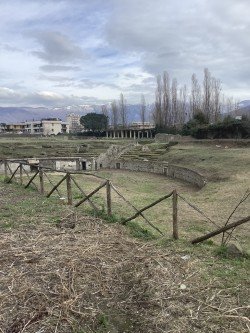XLII Nola (Nuvlana)
What3words – enhanced.army.leader
Construction - 50BC rebuilt 1st Century AD
Capacity - 20,000
Visited January 2025
Status – Half of the amphitheatre is visible, known as the Anfiteatro Laterizo ‘The Brick Amphitheatre’.
To the south and west of Avella at the entrance to the Partenio pass lies Nola, now an outlying suburb of greater Naples. What survived being stormed by Spartacus during his revolt was, being a strategic location, overrun and sacked in successive post Roman Wars. In more recent years the town saw a massacre in September 1943 of Italian Officers in the Town Square by Nazis shortly after the allied landings at Salerno. Nola also lies within the ‘Triangle of Death’ where years of illegal waste dumping by the Camorra in the 1990s has been linked to numbers of cancer deaths far higher than the European average.
With its origins in the middle of the first century BC, the Amphitheatre underwent at least two renovations, one during the first century AD. It was abandoned by the fifth century AD, partially covered by the sixth century eruption of Vesuvius, and quarried to construct the Nola Cathedral, removing almost all of the steps and most of the marble.
The name "brick amphitheater" originates from the sixteenth century. According to tradition, it was where, in AD95, Bishop Felice di Nola was condemned to be fed to lions (or whatever else they had) by order of the prefect Marciano, for having professed the Christian faith. Another of those familiar stories where he was so holy the beasts refused to attack him. Canonisation followed.
Between 1985 and 1993 excavations found three access corridors and some elements of the masonry of the external walls, still covered with plaster. The amphitheatre when complete measured about 138m by 108m. A surviving section of the 2.6m parapet of the arena is covered with rectangular slabs of vertical white marble.
Not an easy visit. The site sits at the end of a cul-de-sac on the outskirts of the town and was deserted in January. At least half of the structure lies beneath parts of the neighbouring industrial estate and a couple of smallholdings and orange groves. It clearly lacks the punch of more spectacular sites and is behind locked gates and fences. Apparently visiting is by appointment only.
I circled and photographed it. On the north side a patch of ground off the road was occupied by several flat bed trailers which, given their partly decomposed contents, get used as an open-air seasonal fruit market. It was fairly easy to step from one of these onto the obviously Roman stone wall between them and the amphitheatre remains. On the premise that it is unwise to enter somewhere if you don’t know how you’re going to get out, I eschewed jumping down the other side on this occasion.


